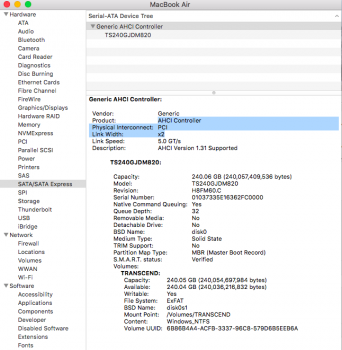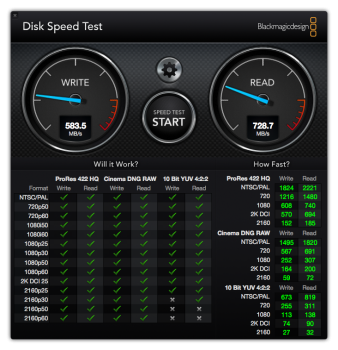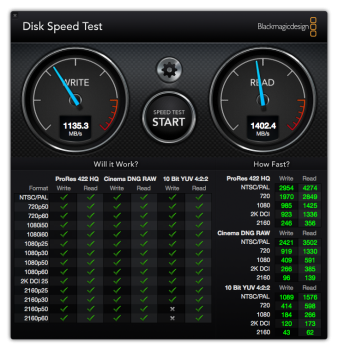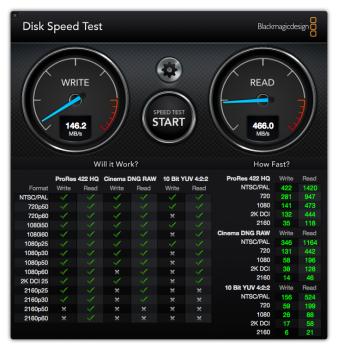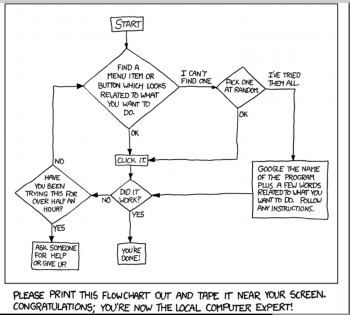THANK YOU TO ALL WHO'VE HELPED BYPASS APPLE'S STORAGE MONOPOLY
This is both a 45-page, historical “development” of problems and solutions. Even ideas that didn’t work were brilliant.
My very LONG post, is intended as a persuasion to (counterintuitively) condense the thread in to:
What does, hasn’t and can’t work… and what will work, EASILY for even a beginner.
If painstakingly evaluated, many effective solutions ARE here. This is (to my knowledge) the best repository serving as the community as a “how to” … to make NVMe storage work in
your (PCIE based) MacBook Pro.
There's just no easy way for someone short on time to winnow the wheat from the chaff as it could be on
any page.
Despite that fact, the content here is to valuable to be lost due to it’s dilute, presently-disorganized arrangement:
A metaphor, if I may, from the nuke world; there’re isotopes available from civilian reactors which are SO! valuable; Bismuth-213 for instance. This isotope, (a surprise product that’s created as a free byproduct in greenhouse gas FREE energy creation), though “free,” is simultaneously PRICELESS. Priceless that is, to the parent of a child with say, Leukemia — or other victims of dispersed cancers for which there’re no practical “cures” in which this isotope of the ingredient which is but an isotope of the same ingredient found in
Pepto-Bismol! To which a parent would perhaps argue that “free” is a misnomer. Perhaps even… “
priceless” would better describe it’s value to said parent.
Only an alpha emitting particle which is brilliantly attached to a nutrient that the cancer cells disproportionately use — allowing the concentration of this alpha emitting radiotherapy to be concentrated in the mutated genetics of Leukemia… to destroy these harmful cells. And now, what was otherwise believed to be an incurable condition as no other chemo, or radiotherapy could redress such dispersed cancers, is now precision targeted by the careful separation of the useful from the unusable… spent fuel. The value, both free and priceless, accurately describe the product. The distinction is in the separation of the useful from the useless.
To some people, though I’ve thoroughly enjoyed reading the great ideas which in some cases still didn’t work, could be a waste of time to read; just as dumping all your spices in to a pile would make them fairly unusable. But much like the separation of the Bismuth-213, the heap of material, or information in this case, could be made substantially more valuable from any perspective, if we whittled it down to the isolates.
This in 45-page format in which the neither the first nor last page have the essence of that learned within, (as I said, though I’ve enjoyed reading it) — would be undeniably more valuable if we could winnow the wheat from the chaff.
Perhaps someone who’s qualified is willing to take initiative and create a sticky? Including only what we either
know or strongly believe to both work and importantly, that which doesn’t. It’d then become:
This is a REQUEST for a group effort to make:
The Ultimate Guide to make NVMe drives work in PCI-E Macs
Color coding Legend. (requests to color code other idea-sections will be implemented as requested)
- ORANGE: Dealing with Apple's 4k cluster requirements.
- BLUE: Is a fresh installation required? Or can a cloned image/restored sparse/DMG work?
- GREEN: Interest in 2TB NVMe drives -- if any exists.
- PINK: Would anyone else like a re-written version of Rehab-Mans (generous) NVMe kexts
Outline Objectives:
I believe clear, consolidated answers to the below will be helpful to others
This is also a request for any additional ideas I overlooked.
All criticism (excluding ad hominem) is welcomed. I couldn't think of a way to make it shorter without omitting elements that may be useful for some people or circumstances.
If a consensus emerges agreeing this to be devoid utility, I apologize & will delete it.
- Consolidate the best / most plausible ideas
- Identify the things that we know cannot, do not, and likely can’t work.
- Separate Apple model groups:
- Size-Year: L13/14 A1398 (differ only in the x2 and x4 speeds) and the Mid 2015 A1398
- Size-Year: L13/14 A1502 (differ only in the x2 and x4 speeds) and the Early 2015 A1502
- Perhaps SMC code would be a smarter choice than this framework.
- Is there a difference based on the manufacture date/month of the device? If so, is there a URL to help?
- Do methods which would make the 950 EVO work on the Pro?
- Do those of the 950 EVO / Pro differ from those of the the 960 EVO / Pro?
- Indicate the info required to provide assistance: SMC, ROM, Build Date, EMC, OS, adapter, drive, size?
- Methods to identify adapters if they purchased without the mfg info: (Color, size, etc)
- URLs to those adapters which work best -- those unlikely to -- those that can't ... with each model.
- Perhaps a generic ‘Troubleshooting Page' ?
- Which NVMe drives are THE easiest to make work.
- Which version of OS X is the easiest to configure, or which requires no configuration.
- If there is a combination of M.2 + OS + adapter which work out the box? This would be awesome info.
- Grading the various OS X versions difficulty, in general.
- Dealing with the necessary 4k cluster size:
- The easiest way to format for in 4k
- Is a Linux machine required?
- Perhaps a link to an easiest process to make a Mac bootable Linux thumb drive?
- Is there an OS X apps for this?
- Can this be done in command line?
- If by hardware, does it have to be directly installed via PCIE? Or does the OWC caddy work?
- What's the easiest way to verify the cluster size.
- There's an app which may help: (Sector_Size_V1.2) -- I just hope that doesn’t violate the TOS.
- Is APFS required? Must it be 10.13.3+ ? Are newer updates easier?
- Is there an update that makes it harder?
- Some people rely on software which precludes use of the optimal OS / File System.
- If they can't use APFS can it be made to work reliably (large file transfers included!) in HFS+ ?
- What must be done to allow 10.12.4 to work? Is 10.12.6 definitively "better/worse"?
- What approach variations are necessary for Sierra 10.12.4 vs. 10.12.6 ?
- Can I help by uploading the OEM NVMe kexts for each OS X iteration?
- It is preferable to perform a FRESH INSTALLATION of OS X if they mess up their kext installation?
- THE BELOW SECTION IS ON INSTALLING OS X ON YOUR NEW NVMe DRIVE'S QUESTIONS:
- When the NVMe drive is installed, is a [fresh installation] mandatory?
- Can restoring from a known good backup via: sparse image/disk/bundle, DMG, cloned image, work?
- If not, why not (if anyone knows) why a fresh installation is superior.
- Has someone restored from a known good OS X clone for it only to fail?
- Is this why a completely fresh installation is advocated?
- Does anyone know WHY this works better than cloning a drive or restoring from an image?
- I haven't even seen discussions of restoring from a DMG/Sparse*/Drive Clone/TimeMachine.
- Ergo, it's advised against — but not discussed.
- Are there other drives as easy as the XG3 out there?
- The MacPro 'king of the hill' SM951 AHCI has made prices skyrocket as supply constrains.
- Other members discussed using the EXPENSIVE 2TB Polaris drive
- The 960 Pro 2TB is pretty affordable yet lacks a single reference in my reading... ?
- Does the lack of reference to the 960 Pro 2TB size suggest its impossible?
- Is the Polaris the only 2TB option?
- Instructions for an affordable 2TB M.2 seem especially useful given the other choices.
- Is the price point of the 960 Pro 2TB the only reason for which we lack info to use it?
- Is the Samsung Evo safer/easier/more compatible than the Pro? Or is this just a pricing issue?
- What are the MOST reliable settings for:
- What's the sleep/hibernation per OS, Model, screen size, ROM, SMC consensus' solution presently?
- The Polaris 2TB -- like all OEM Apple PCIE drives will stay pricy and not fall until replaced.
- All M.2 prices are subject to competition, bad quarters, floods of OEM laptop products.
- Is "Rehab Man's" kext (the best and most current kext)?
- Though I'm INCREDIBLY grateful for the kext, I found RM's instructions difficult to understand.
- I believe Rehab man’s kext instructions are why people ask for alternates EVERYWHERE.
- Would someone like me to re-write those instructions in easier, steb-by-step fashion?
For those of you with Retinas both under and not under AppleCare, should your existing SSD fail, Apple
DISALLOWS upgrading the
size (let alone model) through Apple/The "Genius" bar. Even if you do replace your device with a like-model PCI-E SSD, they'll charge a
fortune and give a paltry 90 day warranty on that part alone.
If you upgrade your SSD DIY style, including purchasing an Apple SSD off eBay that's the IDENTICAL SIZE and version -- whether you're under AppleCare or not, despite it being AN OVERPRICED OEM APPLE SSD -- the SN won't match and, they’d try to void your ENTIRE warranty or deny repairs you're paying them to perform.
Should you entirely replace the device with say an OWC or other manufacturer's product, or, adapt a third party's product, they will act like you have given your laptop HIV and will refuse to do any service unless they can charge you full price to replace the WORKING DRIVE in there as well! And if under AppleCare, they'll act like it's what caused every other thing to break, even if that were a mechanical feature like a keyboard button or even your freaking HINGES. They are not constrained by logic! And will not allow your logic to infect their dogmatic views on invalidating your legal right to services.
More on this issue below under "Warranty Violations”:
This covers legal tactics to fight Apple's attempt to shirk responsibility..
Back to the thread: It contains the
process to upgrade, resolving, problem(s), info on the 'easier' paths via parts that require less effort -- and those scenarios that appear more difficult for people lacking the physical resources of secondary linux boxes, who understood linux, kexts, etc -- from which to use expert-to-expert advice.

All of which is PURE generosity.
We all owe special thanks to MacRumors and those who’ve spent time, money on hardware and expertise in "trial and error" -- which they documented for the benefit of us all.
There the NVMe heroes, who used their years of expertise to voluntarily donate to the community & Mac world how to minimize the
bad / costly, and maximize the
best / most effective methods available.
The thread needs a Jean-François Champollion to create the NVMe-Rosetta-stone.
(Homage to Carl Sagan, Cosmos Part 11 I believe) A simple primer for the layman (me).
I have a special place in my heart for flowcharts (they’re often funny and educational). The work to create this (irrespective the ‘style’ would
need to be updated whenever new/better information emerges: Whether about nuances such as the SMC, or major factors such as make-model or size — and their respective compatibility with each NVMe drive’s model and size.
Example of the joy's of intelligent flowcharts.

Courtesy of
https://xkcd.com/627/
.... a flowchart at the bottom that all techs probably get a kick out of is attached.

I’d volunteer a donation towards this: MacRumors, the creator(s), etc, and imagine others might also?
If I could afford to, (or were a programmer and thought it were possible) I’d create a shareware app which’d allow:
IDing the computer's model/make/firmware/SMC, allowed the specification of the capacity and NVMe model info so, — format the device via an OWC USB caddy, and allowed the trial version of CCC with their permission to restore an appropriate NVMe kext updated version of their OS to be installed from their internal to external drive. Swap the external for the internal, post if on eBay to subsidize your costs, and voila! Another customer allowed to access superior performance to Apple’s drives, with a FULL warranty on the component purchased.

Admittedly, MacRumor’s "beginners" are often more knowledgable than I am. I'd just love to see the work so many people created become mass-available, regardless as to whether the person were a beginner or advanced, or had a linux box to format a drive with.
Some people would possibly pay MacRumors or the largest contributor(s) to the project for a consolidation of the information… such that it’s parsimonious and efficient to determine what works from what didn’t. (And yes, I am aware that my post is hardly better than the entire 45-page thread is.

And I apologize. Perhaps that, in itself makes the point of the ineffectiveness that elongated messages have.)
INFORMATION FOR PEOPLE DENIED SERVICE BY APPLE / APPLECARE:
Whether “Warranty, Quality program, or purchased hardware (i.e. a battery)
Refusal to provide Warranty Service or General Service due to upgrades:
Check out or even bring with you a print out of the Magneson-Moss Warranty Act (available on wikipedia) which proves that this is illegal and subjects them to a lawsuit.
I would recommend withholding the reference to the act until they have provided you documentation as to “why” they’re rejecting your warranty claim, so that they cannot revise the documentation to be compatible with denial of services that doesn’t violate the Magneson-Moss Act. After such documentation is in your possession, for them to change to a subsequent reason would be to engage in “motivated reasoning” which shows prejudice in the performance of services under whichever name allows them to evade the responsibility or agreement to otherwise perform services (punitive bias).
With Depot, they’ll usually have emailed you something to that effect which provides you the perfect opportunity to reply with the legal notice; obviously, the exception would be if the part in which they have to service is the actual part you’ve upgraded. This is effective irrespective whether it's an OEM component that is merely different than the model originally sold with the computer (say, a 512GB Apple SSUBX in a 2014 which was sold with a 256GB SSUAX) or even an OWC model SSD — or CPU for that matter.
Furthermore, as they often allege that such 3rd party parts or different model Apple parts cause harm to the other products which is their cause for invalidating it — still relies upon the legal and scientific principles of argumentation. That is to say, that the onus of proof lies squarely on the person’s shoulders making the claim! Lacking such proof, they remain obligated to perform the services, and would be subject to tort suits for non-performance.
With specific regards to OWC (and even Transcend) drive experiences (potentially anecdotal)
While speaking of SSD drives, I don't want to disparage OWC, but I have had only 20 or so OWC SSD’s come through our hands in the 8 years of business of selling and repairing Macs. On two occasions, I have had OWC drives replaced under warranty in which, the replacement drive either died within a week in one case, and in 2 months in the other. And a surprising number of them which’ve failed generally, under lower usage (using drive testing tools which show us the S.M.A.R.T. data including the hours used, etc.) that suggest to me that we’ve either been unlucky (20 is by far not a “scientific” volume for a study) … or, that it’s indicative of lower quality. I HATE having to say anything but that which is glowing of them, as they’re one of the only manufactures of compatible hardware for PCIE SSDs in Macs that don’t require the kinds of ideas this thread intends to solve, and I will absolutely update this statement if/when my experiences, volumetrically, mitigate my perception of their reliability. Transcend's may in fact be worse, but, are less difficult to obtain an RMA authorization from. Pick your poison.

I must also note that OWC doesn't put up a fight to RMA product -- provided
you have the receipt (i.e., didn’t purchase it IN a computer…)
Samsung on the other hand, has engaged in denial of services that are fraudulent and have compelled me to file a lawsuit in Los Angeles. I'll let you know if I have the gumption to do this and what happens if so.
My
sincerest apologies for errors, ambiguities and crappy syntax requiring a decoder ring.


